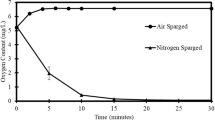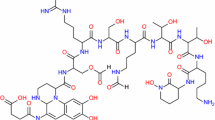Abstract
The performance of grinding media can be misrepresented in marked ball wear tests due to galvanic interactions between dissimilar media. The possible galvanic interaction of media materials during marked ball wear tests has not been adequately explored. Corrosion rates and potentials of modern high carbon steel and high chromium white iron grinding media materials were measured using electrochemical testing as a function of pH and chloride content in a simulated mill water. The results replicate previous research with the high chromium white iron sample being more noble (higher corrosion potential) and corrosion resistant (small corrosion current) than high carbon steel. Using the experimental data and corrosion theory, the effects of galvanic coupling on corrosion rates were calculated to examine what could happen during a marked ball wear test or when a mixed media charge is present. This analysis indicates that high carbon steel can cathodically protect high chromium white iron leading to significant decreases in the corrosion rate (up to 99%) of this material during marked ball wear tests. The magnitude of the protection is a function of the pH of the mill water.

















Similar content being viewed by others
References
Isaacson AE. Effect of sulfide minerals on ferrous alloy grinding media corrosion (1989) U.S. Dept. of the Interior, Bureau of Mines, Report of Investigations 8882
Kawatra SK, Dunne RC, Young CA, Chapter 3.8: Grinding Circuit Design (2019) SME mineral processing & extractive metallurgy handbook, Society for Mining, Metallurgy & Exploration, Inc., Englewood
Aldrich C (2013) Consumption of steel grinding media in mills – a review. Miner Eng 49:77–91
Adam K, Natarajan KA, Riemer SC, Iwasaki I (1986) Electrochemical aspects of grinding media-mineral interaction in sulfide ore grinding. Corrosion 42(8):440–447
Abd-El-Kader H, El-Raghy SM (1986) Wear-corrosion mechanism of stainless steel in chloride media. Corros Sci 26(8):647-653. ISSN 0010-938X
Greet CJ (2012) A protocol for conducting and analysing plant trials: testing of high-chrome grinding media for improved metallurgy. The Southern African Institute of Mining and Metallurgy
Vermeulen LA, Howat DD (1983) Theories of ball wear and the results of a marked-ball test in ball milling. J Southern Afr Inst Min Metall 83(8)
Meulendyke MJ, Moroz PJ, Smith DM (1987) Practical aspects of corrosion in the wear of grinding media. Min Metall Explor 4:72–77
Meulendyke MJ, Purdue JD (1989) Wear of grinding media in the mineral processing industry: an overview. Min Metall Explor. SpringerLink, Springer International Publishing
Schneider CA, Rasband WS, Eliceiri KW (2012) NIH image to ImageJ: 25 years of image analysis. Nat Methods :671–675. https://doi.org/10.1038/nmeth.2089
ASTM Standard E2594–20 (2020) Standard test method for analysis of nickel alloys by inductively coupled plasma atomic emission spectrometry (performance-based). ASTM Int. https://doi.org/10.1520/E2594-20
ASTM Standard E1019–18. Standard test methods for determination of carbon, sulfur, nitrogen, and oxygen in steel, iron, nickel, and cobalt alloys by various combustion and inert gas fusion techniques. (2018) ASTM International. https://doi.org/10.1520/E1019-18
Tolley WK, Nichols Il, Huiatt JL (1984) Corrosion rates of grinding media in mill water. USBM Report of Investigations 8882
Andrade C, Alonso C (2004) Test methods for on-site corrosion rate measurement of steel reinforcement in concrete by means of the polarization resistance method. Materials and Structures. SpringerLink, Kluwer Academic Publishers
Mansfeld F (1973) Tafel slopes and corrosion rates from polarization resistance measurements. Corrosion29(10):397–402
Feng W, Tarakbay A, Ali S, Tang W, Cui H (2021) Methods of accelerating chloride-induced corrosion in steel-reinforced concrete: a comparative review. Constr Build Mater 289:123165
Bin L, Ronggang H, Chenqing Y, Yan L, Changjian L (2010) A study on the initiation of pitting corrosion in carbon steel in chloride-containing media using scanning electrochemical probes. Electrochim Acta 55(22):6542–6545
Lee SF, Garcia JF, Yap SS, Hui D (2022) Pitting corrosion induced on high-strength high carbon steel wire in high alkaline deaerated chloride electrolyte. Nanotechnol Rev 11(1):973–986
Qiu J, Zhu Y, Xu Y, Li Y, Mao F, Wu A (2022) Effect of chloride on the pitting corrosion of carbon steel in alkaline solutions. J Electrochem Soc 169(3):031501
Natarajan KA, Iwasaki I (1991) Electrochemical aspects of grinding ball-mineral interactions in ore grinding. Key Eng Mater 20–28:799–803
Funding
Funding for this research was provided by Molycop.
Author information
Authors and Affiliations
Corresponding author
Ethics declarations
Conflict of Interest
The authors declare no competing interests.
Additional information
Publisher's Note
Springer Nature remains neutral with regard to jurisdictional claims in published maps and institutional affiliations.
Rights and permissions
Springer Nature or its licensor (e.g. a society or other partner) holds exclusive rights to this article under a publishing agreement with the author(s) or other rightsholder(s); author self-archiving of the accepted manuscript version of this article is solely governed by the terms of such publishing agreement and applicable law.
About this article
Cite this article
Fletcher, J.B., Moats, M.S. Understanding Charge Effects on Marked Ball Wear Rates—a Corrosion Study: Part 1. The Impacts of pH and Chloride Concentration. Mining, Metallurgy & Exploration 40, 41–48 (2023). https://doi.org/10.1007/s42461-022-00710-0
Received:
Accepted:
Published:
Issue Date:
DOI: https://doi.org/10.1007/s42461-022-00710-0




